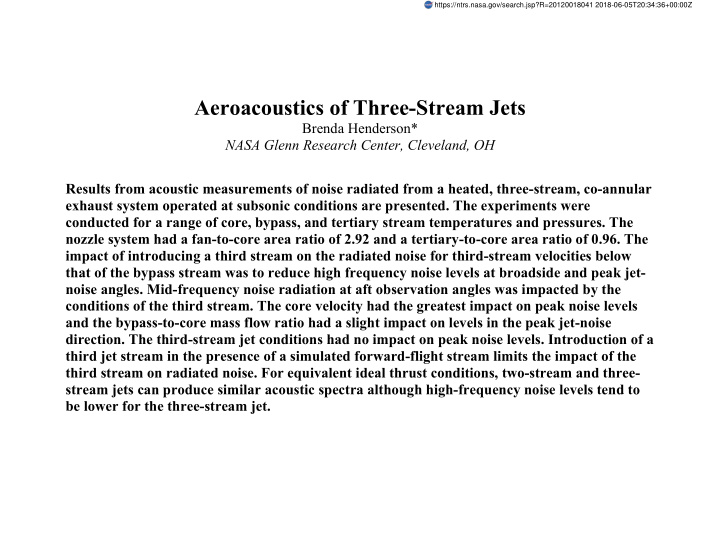



https://ntrs.nasa.gov/search.jsp?R=20120018041 2018-06-05T20:34:36+00:00Z Aeroacoustics of Three-Stream Jets Brenda Henderson* NASA Glenn Research Center, Cleveland, OH Results from acoustic measurements of noise radiated from a heated, three-stream, co-annular exhaust system operated at subsonic conditions are presented. The experiments were conducted for a range of core, bypass, and tertiary stream temperatures and pressures. The nozzle system had a fan-to-core area ratio of 2.92 and a tertiary-to-core area ratio of 0.96. The impact of introducing a third stream on the radiated noise for third-stream velocities below that of the bypass stream was to reduce high frequency noise levels at broadside and peak jet- noise angles. Mid-frequency noise radiation at aft observation angles was impacted by the conditions of the third stream. The core velocity had the greatest impact on peak noise levels and the bypass-to-core mass flow ratio had a slight impact on levels in the peak jet-noise direction. The third-stream jet conditions had no impact on peak noise levels. Introduction of a third jet stream in the presence of a simulated forward-flight stream limits the impact of the third stream on radiated noise. For equivalent ideal thrust conditions, two-stream and three- stream jets can produce similar acoustic spectra although high-frequency noise levels tend to be lower for the three-stream jet.
National Aeronautics and Space Administration Fundamental Aeronautics Program Supersonics Project Aeroacoustics of Three-Stream Jets Brenda Henderson, NASA Glenn Research Center 18 th AIAA/CEAS Aeroacoustics Conference June 4 – 6, 2012 Colorado Springs, Colorado www.nasa.gov
Purpose of Study • Understand noise reduction potential of a third stream that may be available in future engine architectures • Most straight-forward use of third stream is as an additional bypass stream • Need to predict noise from three-stream jets – current semi- empirical tools address single and dual stream jets • Results of co-annular studies may guide other three-stream concepts (ejector)
Aero-Acoustic Propulsion Laboratory (AAPL) • AAPL Microphone Array ‒ 66 foot geodesic dome ‒ 45 foot microphone arc – 24 elements • Nozzle Acoustic Test Rig (NATR) ‒ 53 inch simulated flight stream ‒ Maximum Mach number = 0.35 • High Flow Jet Exit Rig (HFJER) ‒ 3-stream capability (3 rd stream new) ‒ Independent pressure control on all NATR streams HFJER ‒ Independent temperature control on fan and core streams ‒ Fan and third-stream temperatures the same 3
Model Hardware Third-Stream Nozzle Fan Stream Core Nozzle • Core stream nozzles • Round • Lobed mixer • 4.8 inch exit diameter • Fan-to-core area ratio = 2.92 (fixed) • Tertiary-to-core area ratio = 0.92 (fixed) 4
Cycle Points NPR c NPR b NPR t NTR c M fj = 0 M fj = 0.2 M fj = 0.3 1.5 1.5 1.0 - 1.5 2.8 1.6 1.6 1.0 - 1.6 2.8 1.7 1.7 1.0 - 1.7 2.8 1.8 1.8 1.0 - 1.8 2.8 NTR b = 1.25 1.5 1.5 1.0 - 1.5 3.2 1.5 1.4 1.0 - 1.4 3.2 1.5 1.6 1.0 - 1.6 3.2 1.6 1.5 1.0 - 1.5 3.2 1.6 1.6 1.0 - 1.6 3.2 1.6 1.7 1.0 - 1.7 3.2 1.7 1.6 1.0 - 1.6 3.2 1.7 1.7 1.0 - 1.7 3.2 1.7 1.8 1.0 - 1.8 3.2 1.8 1.7 1.0 - 1.7 3.2 1.8 1.8 1.0 - 1.8 3.2 Baseline Experiments • M fj – free jet (simulated flight stream) Mach number • NPR – nozzle pressure ratio • NTR – nozzle temperature ratio Subsonic Exhausts 5
Data Analysis • Baseline Experiments – NPR c = NPR f = 1.8, 1 < NPR t < 1.8 – NTR c = 3.2 – M fj = 0 • Reduced velocity of all streams • Changed velocity ratio (V b /V c ) • Impact of velocity and bypass ratio • Impact of simulated flight stream • Impact of partially mixed flow • Comparison on equal thrust basis
Repeat Acquisitions 150 o 90 o NPR c NPR b NPR t 7
Smoothed Data 150 o 90 o 8
Baseline Results 150 o 90 o Simulated 2-Stream Jet, BPR fan/core = 4.7 Simulated 2-Stream Jet, BPR fan/core = 6.3 Trailing Edge Tones NTR c = 3.2 V b /V c = 0.62 W b /W c = 4.7 9
Reduced Pressure/Velocity 90 o 150 o NTR c = 3.2 V b /V c = 0.62 W b /W c = 4.6 10
Increased Velocity Ratio (V b /V c ) 90 o 150 o NTR c = 2.8 V b /V c = 0.66 W b /W c = 4.3 11
Reduced Velocity Ratio (V b /V c ) 90 o 150 o NTR c = 3.2 V b /V c = 0.59 W b /W c = 3.7 12
Impact of Velocity and Bypass Ratio 90 o 150 o NTR c = 3.2 V b /V c = 0.65, W b /W c = 6.0 V b /V c = 0.66, W b /W c = 4.3 13
Impact of Simulated Forward Flight 90 o 150 o NTR c = 3.2 M fj = 0.3 15
Impact of Partially Mixed Core and Fan NTR c = 3.2 M fj = 0.3 150 o 90 o 16
Equal Thrust Comparisons 90 o 150 o 17
Conclusions • Addition of a third stream reduced high-frequency noise and impacted mid-frequency noise • The presence of a simulated flight stream reduced the impact of the third stream • The core-stream velocity had the greatest impact of all parameters investigated on the radiated noise • Comparisons on an equal thrust basis show that three- stream jets are not inherently quieter than two-stream jets
Recommend
More recommend